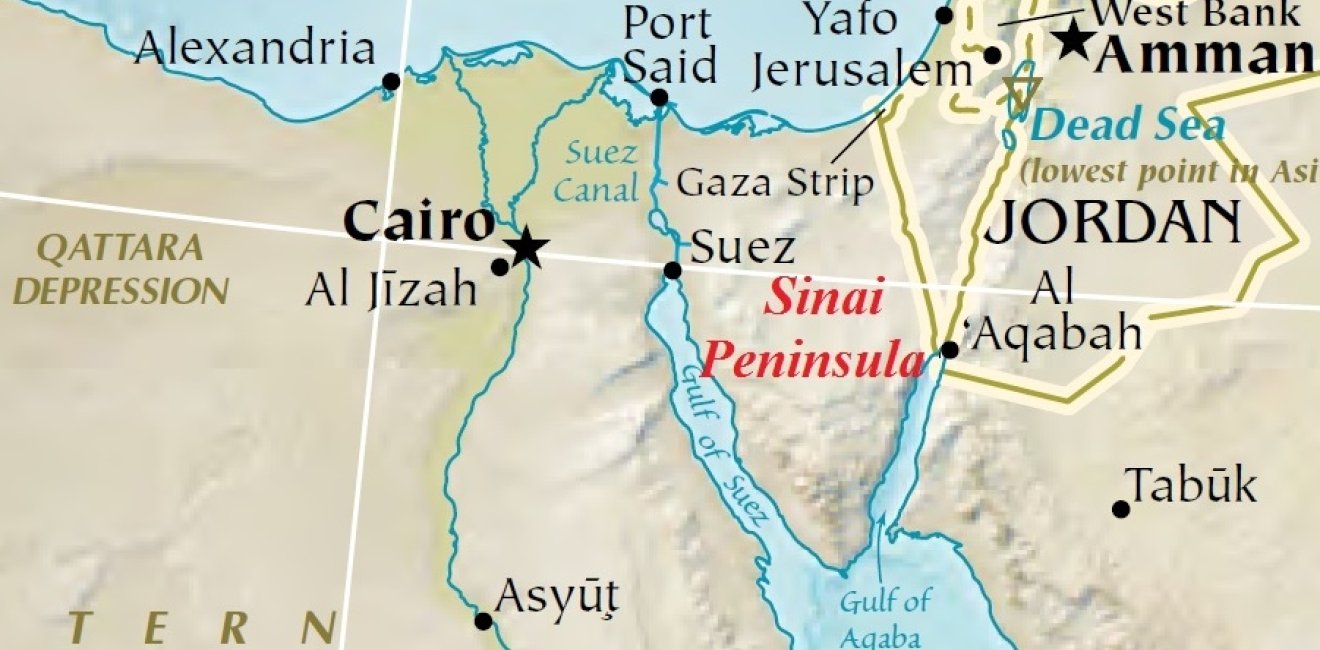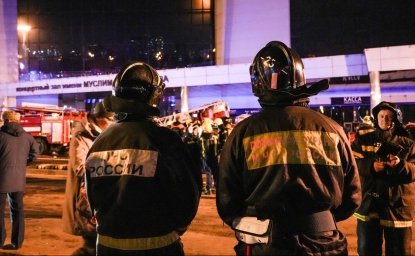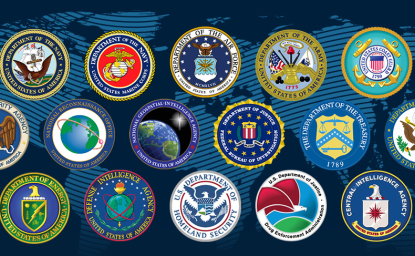The Sinai: Jihadism's Latest Frontline
The Sinai crisis has evolved from a local struggle for autonomy to the latest frontline of jihadi extremism in the Middle East.
The Sinai crisis has evolved from a local struggle for autonomy to the latest frontline of jihadi extremism in the Middle East.

The Sinai crisis has evolved from a local struggle for autonomy to the latest frontline of jihadi extremism in the Middle East. Extremists carried out the biggest terrorist attacks in modern Egyptian history on November 24, 2017, when more than 300 worshippers were killed and dozens more injured at a Sufi mosque in a remote northern Sinai town. One militant reportedly carried the black-and-white ISIS flag.
The Sinai Peninsula, a triangular province about the size of West Virginia, is home to an increasingly aggressive branch of the Islamic State as well as smaller jihadist cells. The largest jihadi group originally supported al Qaeda, but switched loyalty to the rival the Islamic State in 2014. Other jihadi groups are linked to the drug trade, criminal gangs, or illegal immigration. Allegiances are fluid.
By mid-2017, lawlessness in Egypt’s hinterland threatened the government of President Abdel Fateh el Sisi. It also endangered other parts of the strategic region, including the oil-rich Gulf; neighboring Israel; the Palestinian Authority and the fragile peace process; and North African countries already struggling with political, economic and societal turbulence. Foreign fighters — largely from Libya, the Maghreb, and Europe — have migrated to the Sinai, where they constituted as much as 80 percent of the Sinai Province’s fighting force by mid-2017, according to a spokesman from the Tarabin tribe. With the collapse of the Islamic State’s caliphate in Syria and Iraq, it could become an alternative hub for jihadis.
Below is an interactive map of the Sinai. Click on the color-coded points for details on attacks.
Egypt has witnessed several phases of militancy — first in the early 1980s, again in the early 1990s, and in the mid-2000s. The current challenge began in 2011. It grew out of a Bedouin struggle for political and economic autonomy during the Arab Spring. It was inspired by dissident Salafist clerics from mainland Egypt and the adjacent Gaza Strip who preached militant action against both Egypt and Israel. It was aided by the ouster of Moammar Qaddafi in 2011, when Libyan arms began flooding black markets in the Sinai.
The first major attack by Sinai jihadis, in 2012, killed 16 Egyptian soldiers near the Rafah border crossing with Israel. One of their biggest attacks was the bombing of a Russian Metrojet flight in 2015, killing 224. By mid-2017, the jihadi insurgency had mutated into a guerrilla campaign, with almost weekly attacks carried out by fighters hiding among the civilian population. Their bloodiest attack was the November 2017 bombing and shooting of worshipers at the Rawda mosque.
But jihadism in the Sinai has also produced a backlash. Some Bedouin tribes, who had once rebelled against the government, turned against the extremists in 2017. The counter-revolt began in April, when leaders of the influential Tarabin tribe called on other tribes to unite against the Sinai Province. In May, the Tarabin killed eight Sinai Province operatives and then issued a joint statement, with other major Sinai tribes, warning youth to abandon any affiliation with extremists. Attacks were down sharply by August 2017.
The Sinai Province of the Islamic State was declared on November 10, 2014. It grew out of Ansar Bayt al Maqdis (the Supporters of Jerusalem), an indigenous terror group formed in 2011. In mid-2017, the group was estimated to have anywhere from 200 to 2,000 fighters, despite high death tolls in clashes with Egyptian security forces. It had small arms, artillery, and anti-aircraft and anti-tank missiles. One of its propaganda videos showed some large vehicles, including a tank. Terror attacks in the Sinai Peninsula are often difficult to attribute. Yet data indicates that the Sinai Province was responsible for at least one third of the 941 reported terror attacks in the Sinai between the fall of President Hosni Mubarak in February 2011 and August 2017.
Abu Osama al Masri, the nom de guerre of Muhammad al Isawi, has led the group since August 2016. Little is known about him. He graduated from al Azhar University, the oldest center of religious learning in Egypt. He negotiated the Sinai Province’s pledge of allegiance to the Islamic State after visiting Syria in 2014. As leader and spokesman for the Sinai Province, he has called for the assassinations of Egyptian judges and claimed responsibility for the group’s downing of Russian Metrojet Flight 9268.
The Sinai Province professes jihadi Salafism, which seeks to establish a state based on strict Islamic principles dating back to practices when the faith was founded in the seventh century. It views any Muslims who disagree as apostates. The group initially exploited Bedouin religious divisions to gain power and then persecuted other Muslim sects after becoming the largest jihadi force. It pledged allegiance to Abu Bakr al Baghdadi, the ISIS caliph who claimed to be the rightful ruler of all Muslims.
The group’s early focus was on Israel’s destruction. It gained early notoriety from a 2012 attack on the Arab Gas Pipeline, an important natural gas source for Israel. It launched rocket attacks against Israel and sent fighters to Gaza during Israel’s 2012 incursion. The group uses extreme anti-Semitic rhetoric. It has threatened to “purge the earth of [Israel’s] filth.” It claimed that the notoriously Islamophobic short film “Innocence of Muslims” was a Jewish conspiracy.
Its aspirations have grown to include toppling the Egyptian state, including President Sisi and his security forces. In September 2013, the group condemned the Egyptian Army as criminals and barbarians. It claimed that Egypt is the “spearhead” of a secular coalition — of Muslims, Jews, and Western “crusaders” — opposed to Salafi ideals. In a 2014 sermon, Abu Osama blamed tyrants and borders for foiling the emergence of a global caliphate. The Sinai Province has often compared the state’s campaign against Sinai residents’ homes and farms to economic warfare because it favors the interests of a narrow elite in Egypt.
The Sinai Province has moved from hit-and-run tactics to embryonic attempts at state-building, mirroring its parent organization’s strategy. The group began seizing territory in July 2015, with the short-lived capture of Sheikh Zuwaid, a village in the northeast. By 2017, it exerted wide influence in Rafah and al Arish, the North Sinai Governorate capital, and raised flags over structures it captured. It created institutions, including religious police, to enforce its ultra-conservative vision.
The terror group’s rise has produced backlash, however. In 2014, Bedouin tribesmen killed the group’s former leader, Shadi al Manaei, in retribution. In 2017, a similar cycle of violence between jihadists and local Bedouin tribes erupted into open revolt by the powerful Tarabin tribe. By April 2017, the Tarabin rebellion led the jihadis to issue a conciliatory statement calling violence “unfortunate.” A media outlet linked to the Sinai Province called on “our brothers the Tarabin” to solve differences between the two peacefully.
Al Qaeda in the Sinai Peninsula is an umbrella organization of groups and operatives still loyal to al Qaeda. Many of its members split from the Sinai Province after the Sinai Province declared its loyalty to the Islamic State. It includes groups such as the Mujahideen Shura Council, Ansar al Jihad, and Jamaat al Murabiteen. Jund al Islam, one of its component organizations, attacked military intelligence bases in Rafah in 2013.
Al Furqan Brigades attacked shipping in the Suez Canal in August 2013. The group, which may be linked to al Qaeda, has threatened to disrupt trade in retribution for what it called a “vicious attack by Egypt’s Crusaders on Islam.”
Jaysh al Islam (Army of Islam) attacked Egyptian soldiers breaking their Ramadan fast in 2012. A rival to Hamas, this Gazan group under the command of Momtaz Doghmush began operating in the Sinai in the early 2010s.
Takfir wal Hijra (Excommunication and Exodus) conducted attacks in 2011, but has been less active since a 2013 raid eliminated some of its core leadership. The group’s name harkens back to an infamous splinter cell of the Muslim Brotherhood responsible for a wave of terror in the 1970s.
Tawhid wal Jihad (Monotheism and Holy War) was infamous for attacks on the coastal tourist towns of the Gulf of Aqaba in the mid-2000s. The group reportedly still operates out of Sinai and Gaza.
The vast deserts, scrublands and mountains of the Sinai cover an area of 23,500 square miles. Most population centers are clustered on the coasts, while the interior contains important religious sites such as Saint Catherine’s Monastery and Mount Sinai. The peninsula is the sole terrestrial link between the Middle East and North Africa. This comes with several geostrategic implications.
The Western Edge of the Sinai is bound by the Suez Canal, a critical artery of international trade. Almost 10 percent of the world’s sea-bound trade flows through the Suez, despite increasing competition from newly opened Arctic routes and an expanded Panama Canal. As many as 3.2 billion barrels of oil pass through the Suez every day, making the canal one of the world’s great chokepoints for oil transit. Tariffs on maritime traffic through the canal furnish important revenues for the cash-strapped Egyptian state.
The crisis in the Sinai has threatened all of this. The al Furqan Brigades, a Sinai-based terror group, have made it their mission to threaten traffic along the canal. The terrorists forced the Egyptian state to bolster canal security after attacking shipping vessels in 2013. Renewed attacks on international trade could further damage Egypt’s precarious economic situation.
To the East, the deserts of the Sinai border Israel and the Gaza Strip. Israel and Egypt have fought four major campaigns in the Sinai: The Arab-Israeli War in 1948; the Suez Crisis of 1956; the Six-Day War of 1967; and the Yom Kippur War of 1973. Israel occupied the Sinai Peninsula from 1967 until it evacuated its last settlement in 1982 following the success of the Camp David Accords. The demilitarization of the Sinai has remained a cornerstone of regional peace ever since.
The Egypt-Israel Peace Treaty of 1979 places limits on Egyptian military deployments to the peninsula. In 2011, Israel agreed to raise these limits for the first time since the implementation of the agreement. It has approved several requests to increase this limit since, but the ongoing Sinai insurgency has tested the bilateral approval process. Without prior approval, Egypt deployed tanks to the Sinai for the first time since 1967 in response to the crisis.
The militants’ transnational aspirations further endanger Egypt and Israel’s delicate diplomatic arrangement. Underground tunnels between Gaza and Egypt in the border town of Rafah have enabled the free transfer of goods, weapons and people. The Sisi government demolished many tunnels and imposed a wider buffer zone, but Sinai jihadis have continued to carry out cross-border rocket attacks and incursions into Israeli territory. Sinai’s status as a haven for Palestinian jihadists cuts both ways, as rivals of Hamas have used the territory to escape Hamas’s crackdowns in Gaza. The Sinai Province claimed an attempted assassination against Hamas in 2015, calling it “the government of apostasy” and warning it against attacking Salafis. Salafi groups continued to attack Hamas on the border with Sinai in August 2017.
Across the Gulf of Aqaba, the Sinai Peninsula also shares proximity with Jordan and oil-rich Saudi Arabia, both considered crucial security partners in the global effort to eliminate terrorism. The Sinai Province and other groups have repeatedly bombed a major gas pipeline to Jordan, most recently in 2016. Gas exports through the Arab Gas Pipeline, already limited due to a domestic shortage of natural gas, have failed to take off. Full-scale attacks launched from the Sinai could destabilize Saudi Arabia, already struggling with unrest in its Eastern Province and a war in Yemen.
Total Terror Attacks in the Sinai By Year
2017*
35
14
444
222
2016
270
122
448
455
2015
260
132
666
631
2014
118
42
163
214
2013
212
4
128
246
2012
40
-
32
34
2011
12
-
5
8
Total
941
306
1556
1652
Aug. 5, 2012: Jihadists attacked a police outpost in northeastern Rafah while attempting to enter Israel, killing 16 police officers.
Aug. 13, 2013: Terrorists ambushed a police convoy in Rafah, killing 24 police officers and prompting the government to declare three days of national mourning.
Sep. 2, 2014: Members of Ansar Bayt al Maqdis (which would later become the Sinai Province) attacked an army convoy in Rafah, detonating a roadside bomb and then shooting the survivors. They killed 11 members of Egypt’s security forces.
Oct. 24, 2014: Ansar Bayt al Maqdis assaulted an army checkpoint in the northeastern village of Sheikh Zuwaid, detonating a car bomb and then following up with rocket propelled grenades. Some 28 soldiers died in the attack.
Jan. 29, 2015: The Sinai Province killed 26 people including policemen, soldiers and civilians in coordinated car bomb and mortar attacks on security checkpoints in al Arish, the capital of North Sinai.
July 1, 2015: The Sinai Province launched coordinated attacks at seven army positions in Sheikh Zuwaid and al Arish. It was the largest battle in the Sinai insurgency to date. Some 21 soldiers were killed as well as over 100 militants.
July 15, 2015: The Sinai Province attacked a highway checkpoint outside of Sheikh Zuwaid. The military and militants gave differing accounts of the fatalities, but the Global Terrorism Database of the National Consortium for the Study of Terrorism and Responses to Terrorism recorded 20 deaths among the assailants.
Oct. 31, 2015: A bomb planted by the Sinai Province detonated on board Russian Metrojet Flight 9268 from the tourist city of Sharm El Sheikh, causing the plane to crash and killing all 224 onboard. As of 2017, it remained the largest single attack perpetrated by the Sinai Province.
Jan. 14, 2016: The Sinai Province engaged the Egyptian military in a major firefight at a security checkpoint in Sheikh Zuwaid. The jihadis killed four soldiers, losing 30 fighters in the battle.
March 19, 2016: Mortar strikes by the Sinai Province killed 13 soldiers at a checkpoint in al Arish.
Oct. 14, 2016: The Sinai Province bombed army positions west of al Arish with mortar rounds and rockets, killing a dozen soldiers.
Aug. 9, 2017: The Sinai Province ambushed a police car outside of el Arish in Northern Sinai, killing four policemen.
July 7, 2017: The Sinai Province detonated car bombs at two checkpoints south of Rafah in the deadliest terror attack in the Sinai in years. The bombs killed 26 soldiers and a subsequent gunfight left 40 militants dead.
Sep. 11, 2017: Sinai Province fighters destroyed three armored vehicles in a roadside bomb attack, then proceeded to ambush the survivors with machine gun fire. At least 18 police were killed.
Oct. 13, 2017: The Sinai Province attacked a military post and killed at least six Egyptian soldiers.
Oct. 15, 2017: More than 100 Sinai Province fighters attacked security outposts in north Sinai, killing six soldiers and injuring more than 20 security force members. At least 24 Sinai Province fighters were killed in the attack.
Nov. 24, 2017: Militants detonated a bomb inside a Sufi mosque in a remote north Sinai town and opened fire on worshipers, killing at least 305 and injuring more than 128 others. It was the deadliest terrorist attack in Egypt’s modern history. No group officially claimed responsibility, but one militant reportedly carried the black-and-white ISIS flag.
Evan W. Burt was a research assistant at the Wilson Center during the summer of 2017.

Learn more about Hamas and how it relates to similarly aligned organizations throughout the region. Read more



